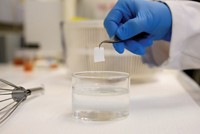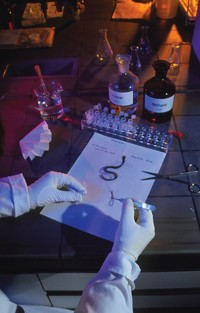Advertisement
Grab your lab coat. Let's get started
Welcome!
Welcome!
Create an account below to get 6 C&EN articles per month, receive newsletters and more - all free.
It seems this is your first time logging in online. Please enter the following information to continue.
As an ACS member you automatically get access to this site. All we need is few more details to create your reading experience.
Not you? Sign in with a different account.
Not you? Sign in with a different account.
ERROR 1
ERROR 1
ERROR 2
ERROR 2
ERROR 2
ERROR 2
ERROR 2
Password and Confirm password must match.
If you have an ACS member number, please enter it here so we can link this account to your membership. (optional)
ERROR 2
ACS values your privacy. By submitting your information, you are gaining access to C&EN and subscribing to our weekly newsletter. We use the information you provide to make your reading experience better, and we will never sell your data to third party members.
Analytical Chemistry
Private Eye In The Lab
New tools and analytical methods aid chemists in forensic investigations
by Mitch Jacoby
April 3, 2006
| A version of this story appeared in
Volume 84, Issue 14
COVER STORY
Private Eye In The Lab
From Pittcon
Armed with little more than a magnifying glass, fictional detectives solve murder mysteries and other crime puzzles by drawing upon uncommonly acute powers of observation and deductive reasoning. Real detectives tend to lean more heavily on analytical chemistry to help get the job done. Researchers who focus on the analysis of crime scenes gathered at Pittcon last month to share some of their latest findings at a symposium devoted to analytical developments in forensic investigations.
Brittany M. Baguley, a postdoctoral researcher working with University of South Carolina chemistry professor Stephen L. Morgan, is developing methods based on gas chromatography-mass spectrometry for determining the chemical composition of fingerprint residues. A key goal of the work is to identify components of the residue that correlate with age, gender, and other personal information that may be useful in determining who left the prints.
Baguley noted that fingerprint residues tend to be composed of inorganic salts, urea, and amino acids that are secreted by eccrine glands, which are abundant in palms and fingertips. The residues also contain cholesterol, fatty acids, and alcohols, all of which are produced by sebaceous glands, which are found on the scalp, face, and other parts of the body. Baguley pointed out that although sebaceous glands are not found in fingertips, the secretions associated with those glands are typically found in fingerprint residues because people touch their faces frequently.
Analyzing residues transferred to glass beads by volunteer subjects, the South Carolina team found that a number of compounds, including squalene, cholesterol, palmitic acid, and myristic acid, were found in residues from all subjects, yet the relative concentrations varied widely among subjects, as reported previously by other researchers. The group also found unique compounds that were associated with specific subjects. For example, octyl methoxycinnamate, a sunscreen and cosmetic ingredient, was identified in the prints of some of the female subjects and nicotine in the fingerprints of a smoker. Baguley added that preliminary results suggest that urea is found in greater concentration in the prints of males than of females. The team is examining the gender-dependent results and other findings in follow-up studies that involve a larger sample pool and additional standardized sample-collection procedures.
Rob a bank and you may end up with more than body oils on your hands. Financial institutions often plant dye packs in stacks of currency to deter and catch robbers and to aid in retrieving stolen money. The packs contain an indelible dye, typically 1-methylaminoanthraquinone (1-MAAQ), and a remote triggering system that causes the packs to rupture automatically and shower a burglar and the loot with a permanent red stain.

Because solvents won't dissolve the dye, treating the stained money with bleach may seem to a criminal (or to a law-abiding citizen, for that matter) like a good way to remove the color. For that reason, researchers at the FBI Laboratory in Quantico, Va., studied the reaction of 1-MAAQ with sodium hypochlorite (the key component in bleach) and methods for separating and detecting the products. The information could aid law-enforcement officials in tracking down bank robbers and recovering money that's been laundered-literally.
As it turns out, even after bleaching, the money tends to remain stained, according to FBI forensic chemist Michael P. Rickenbach, who reported on the study. He noted that the reaction produces three products, o-chloro-MAAQ, p-chloro-MAAQ, and dichloro-MAAQ, and he summarized two chromatography methods (GC and LC) for separating and detecting them.
Another FBI chemist, Eshwar Jagerdeo also reported on developments in forensics analysis. Jagerdeo remarked that laboratory investigations would proceed much more efficiently were it not for "the sample preparation bottleneck, which consumes most of our time." So when the FBI lab installed the new direct analysis in real time (DART) sample introduction system that's coupled to a time-of-flight mass spectrometer, he was delighted because the device analyzes samples generally in less than one minute.
The instrument, which is manufactured by JEOL USA in Peabody, Mass., debuted at Pittcon last year and has been turning heads ever since. That's because its sample-inlet system enables a wide variety of samples to be introduced directly at atmospheric pressure without any sample preparation simply by holding the sample near the inlet (C&EN, March 7, 2005, page 45). Ionization is based on the interaction of analyte molecules with energetic helium atoms in a plasma.
Down on the Pittcon exposition floor, a crowd of conventioneers lingered at the JEOL booth, as product manager Robert B. Cody, who coinvented the DART system with James A. Laramée, grabbed samples of anything handy to demonstrate the method. Quickly wiping an orange peel and holding the swab near the inlet revealed two fungicides: thiabendazole and imazalil. And waving a tiny dab of melted chocolate near the DART inlet showed the presence of theobromine and caffeine within seconds.
MORE ON THIS STORY
- Better Than Ever At Pittcon 2006
- Pittcon, Other Trade Shows May Be Declining In Importance For Small Firms
- Shimadzu Exhibits 50-Year-Old Gas Chromatograph At Pittcon
- Analyzing Vaccines
- Bioimaging With Mass Spectrometry
- Private Eye In The Lab
- Multitasking Cells
- Building Bridges
- Chinese Instrument Market Warms Up
- New & Notable At Pittcon 2006
Advertisement
Sherlock Holmes may continue to enjoy special status as a detective superhero because of his storied powers of observation. But with steady advances in analytical techniques, forensic chemists may soon give him a run for his money.






Join the conversation
Contact the reporter
Submit a Letter to the Editor for publication
Engage with us on Twitter